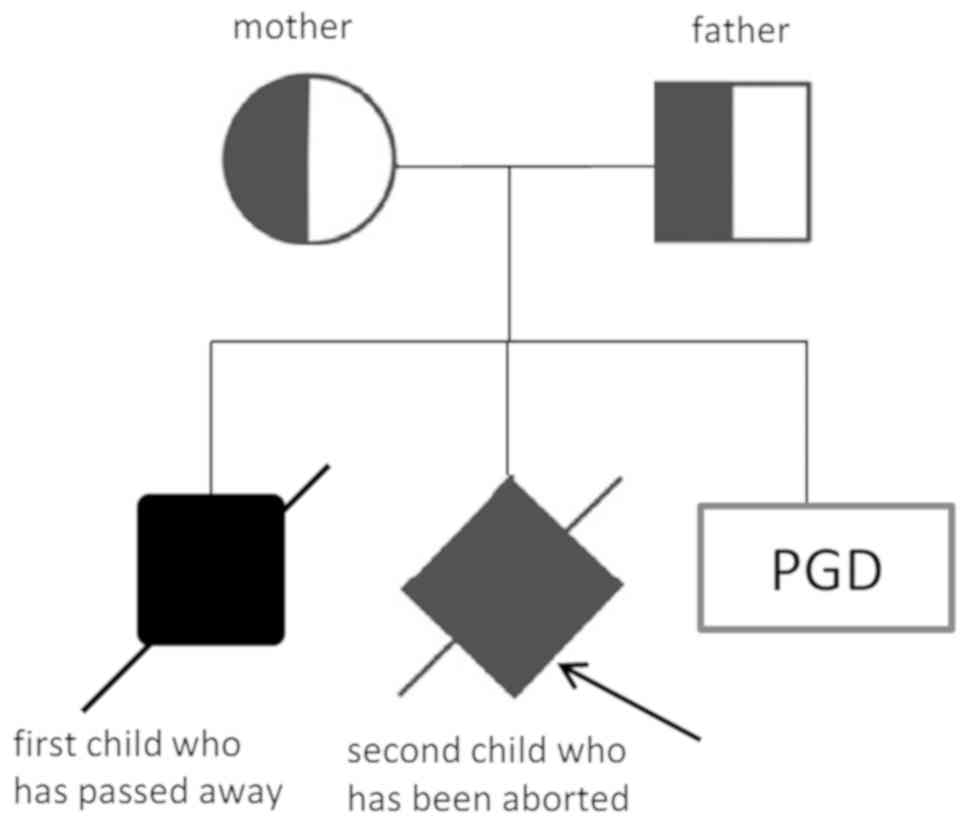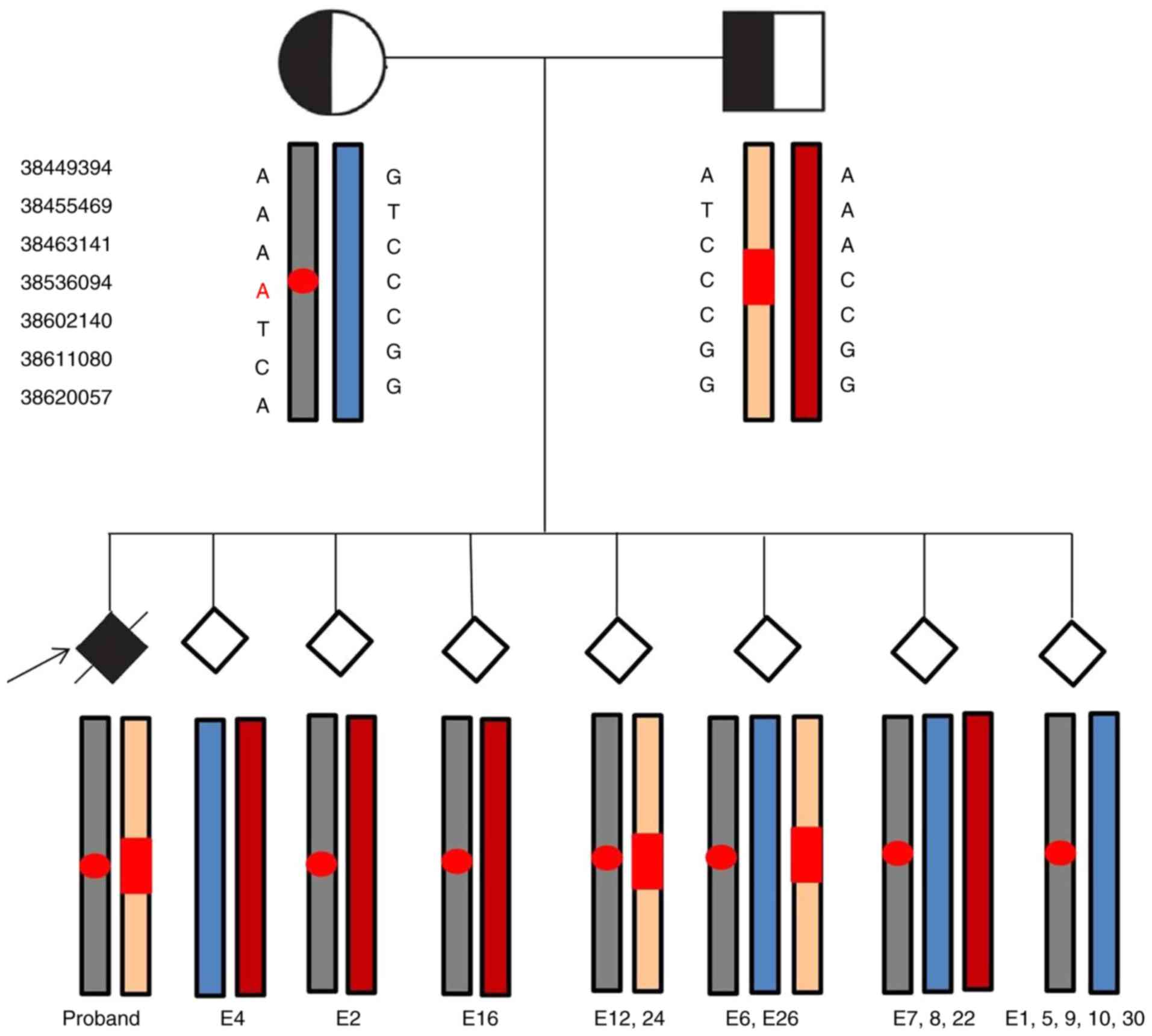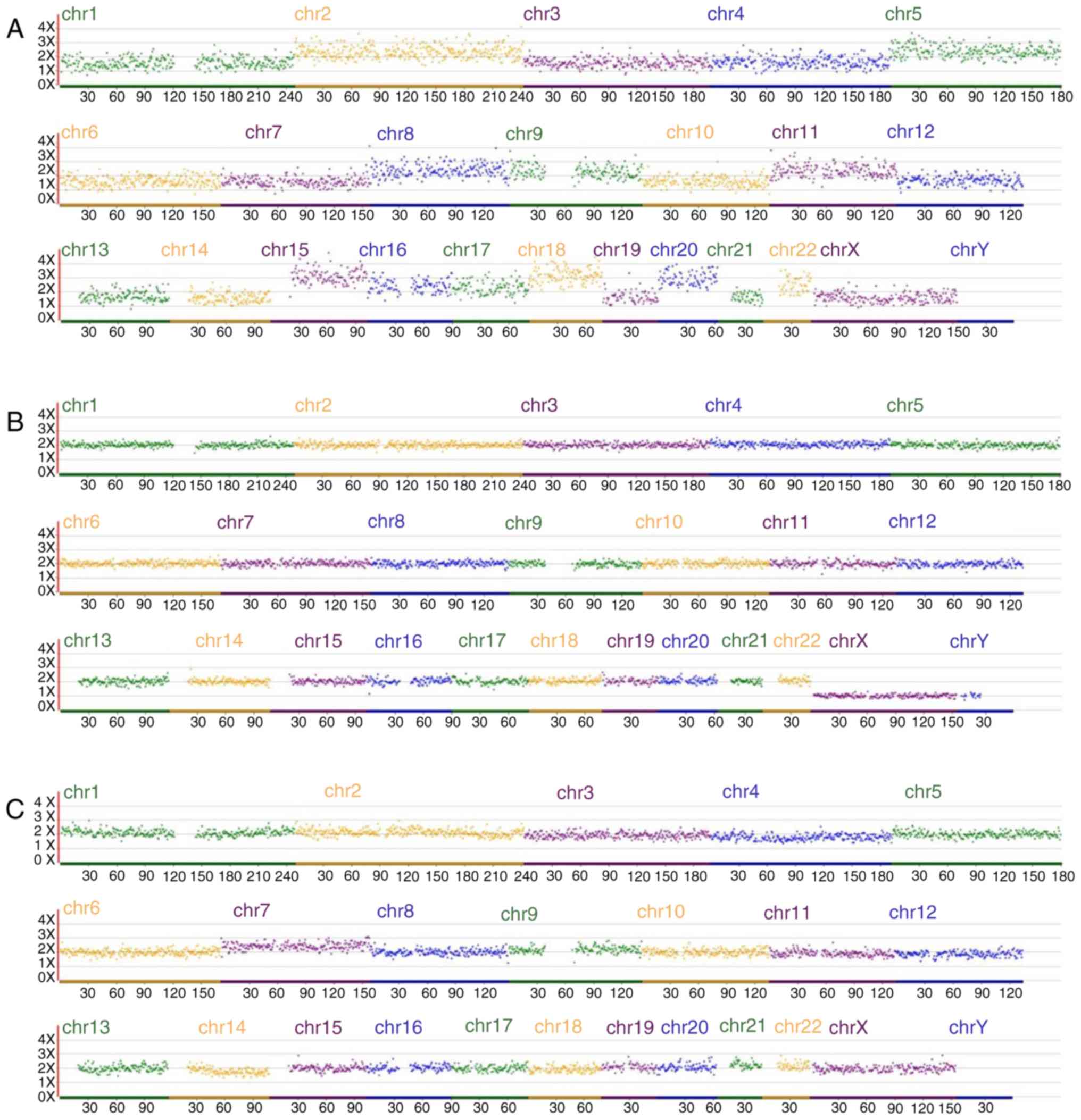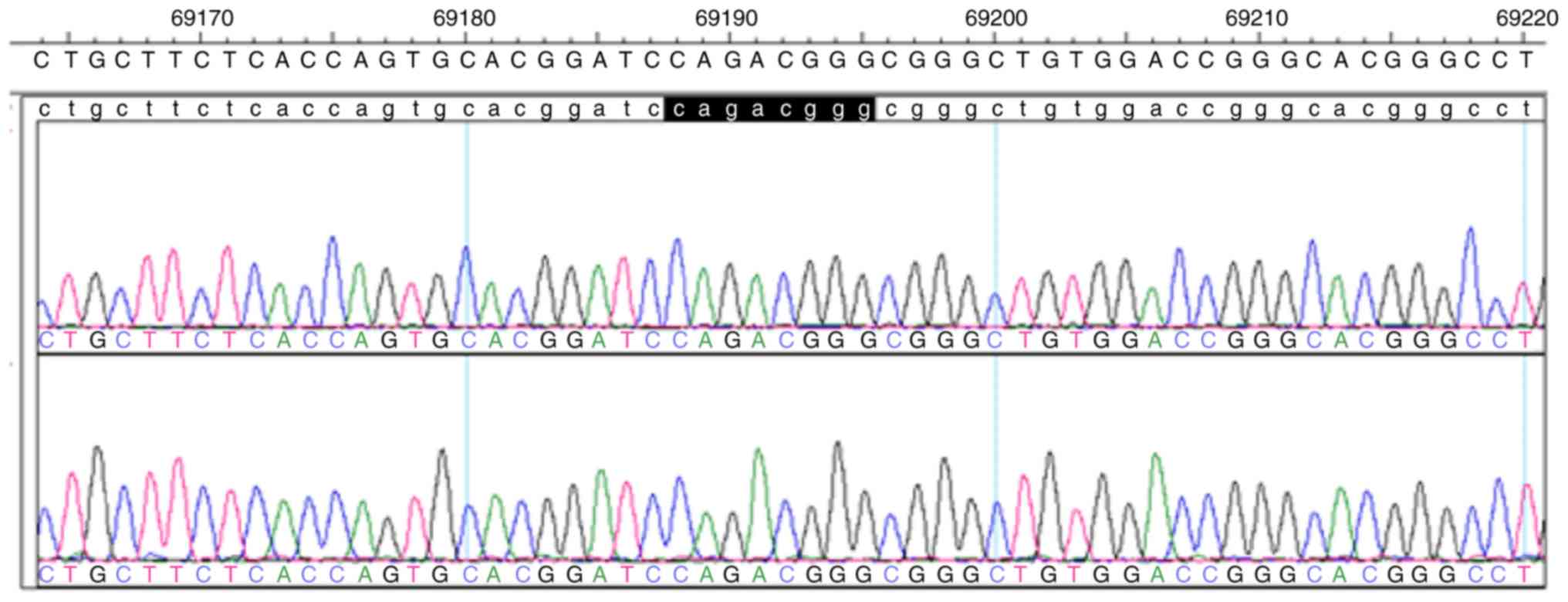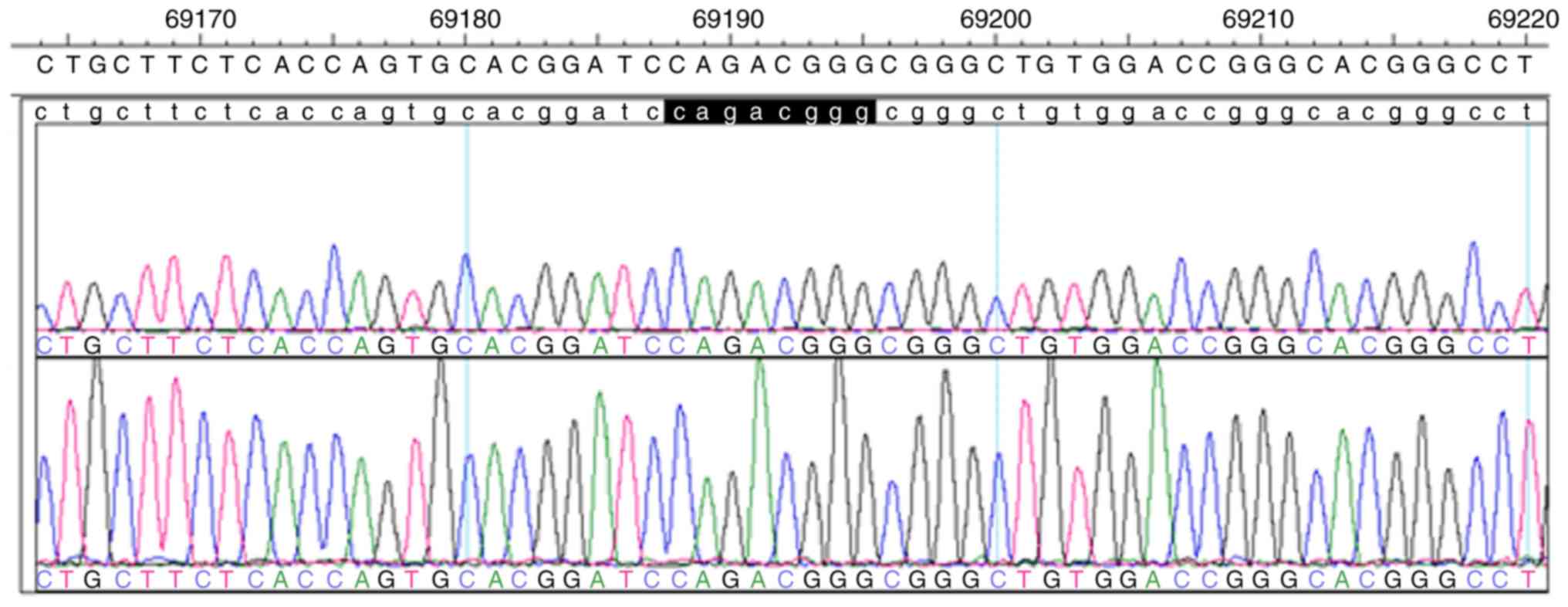|
1
|
Iodice A, Spagnoli C, Salerno GG, Frattini
D, Bertani G, Bergonzini P, Pisani F and Fusco C: Infantile
neuroaxonal dystrophy and PLA2G6-associated neurodegeneration: An
update for the diagnosis. Brain Dev. 39:93–100. 2017. View Article : Google Scholar : PubMed/NCBI
|
|
2
|
Wu Y, Jiang Y, Gao Z, Wang J, Yuan Y,
Xiong H, Chang X, Bao X, Zhang Y, Xiao J and Wu X: Clinical study
and PLA2G6 mutation screening analysis in Chinese patients with
infantile neuroaxonal dystrophy. Eur J Neurol. 16:240–245. 2009.
View Article : Google Scholar : PubMed/NCBI
|
|
3
|
Khateeb S, Flusser H, Ofir R, Shelef I,
Narkis G, Vardi G, Shorer Z, Levy R, Galil A, Elbedour K and Birk
OS: PLA2G6 mutation underlies infantile neuroaxonal dystrophy. Am J
Hum Genet. 79:942–948. 2006. View
Article : Google Scholar : PubMed/NCBI
|
|
4
|
Engel LA, Jing Z, O'Brien DE, Sun M and
Kotzbauer PT: Catalytic function of PLA2G6 is impaired by mutations
associated with infantile neuroaxonal dystrophy but not
dystonia-parkinsonism. PLoS One. 5:e128972010. View Article : Google Scholar : PubMed/NCBI
|
|
5
|
Morgan NV, Westaway SK, Morton JE, Gregory
A, Gissen P, Sonek S, Cangul H, Coryell J, Canham N, Nardocci N, et
al: PLA2G6, encoding a phospholipase A2, is mutated in
neurodegenerative disorders with high brain iron. Nat Genet.
38:752–754. 2006. View
Article : Google Scholar : PubMed/NCBI
|
|
6
|
Handyside AH, Kontogianni EH, Hardy K and
Winston RM: Pregnancies from biopsied human preimplantation embryos
sexed by Y-specific DNA amplification. Nature. 344:768–770. 1990.
View Article : Google Scholar : PubMed/NCBI
|
|
7
|
Treff NR, Fedick A, Tao X, Devkota B,
Taylor D and Scott RT Jr: Evaluation of targeted next-generation
sequencing-based preimplantation genetic diagnosis of monogenic
disease. Fertil Steril. 99:1377–1384.e6. 2013. View Article : Google Scholar : PubMed/NCBI
|
|
8
|
Kurekci E, Küpesiz A, Anak S, Öztürk G,
Gürsel O, Aksoylar S, Ileri T, Kuşkonmaz B, Eker İ, Cetin M, et al:
Hematopoietic stem cell transplantation using preimplantation
genetic diagnosis and human leukocyte antigen typing for human
leukocyte antigen-matched sibling donor: A Turkish Multicenter
Study. Biol Blood Marrow Transplant. 23:790–794. 2017. View Article : Google Scholar : PubMed/NCBI
|
|
9
|
Sallevelt SC, Dreesen JC, Drüsedau M,
Hellebrekers DM, Paulussen AD, Coonen E, van Golde RJ, Geraedts JP,
Gianaroli L, Magli MC, et al: PGD for the m.14487 T>C mitoch
ondrial DNA mutation resulted in the birth of a healthy boy. Hum
Reprod. 32:698–703. 2017.PubMed/NCBI
|
|
10
|
Lee VC, Chow JF, Lau EY, Kwong A, Leung
SY, Yeung WS, Ho PC and Ng EH: Preimplantation genetic diagnosis
for hereditary cancer syndrome: Local experience. Hong Kong Med J.
22:289–291. 2016. View Article : Google Scholar : PubMed/NCBI
|
|
11
|
Dreesen J, Destouni A, Kourlaba G, Degn B,
Mette WC, Carvalho F, Moutou C, Sengupta S, Dhanjal S, Renwick P,
et al: Evaluation of PCR-based preimplantation genetic diagnosis
applied to monogenic diseases: A collaborative ESHRE PGD consortium
study. Eur J Hum Genet. 22:1012–1018. 2014. View Article : Google Scholar : PubMed/NCBI
|
|
12
|
Shen J, Cram DS, Wu W, Cai L, Yang X, Sun
X, Cui Y and Liu J: Successful PGD for late infantile neuronal
ceroid lipofuscinosis achieved by combined chromosome and TPP1 gene
analysis. Reprod Biomed Online. 27:176–183. 2013. View Article : Google Scholar : PubMed/NCBI
|
|
13
|
Trachoo O, Satirapod C, Panthan B,
Sukprasert M, Charoenyingwattana A, Chantratita W, Choktanasiri W
and Hongeng S: First successful trial of preimplantation genetic
diagnosis for pantothenate kinase-associated neurodegeneration. J
Assist Reprod Genet. 34:109–116. 2017. View Article : Google Scholar : PubMed/NCBI
|
|
14
|
Liu X, Xu Y, Sun J, Zhang Z, Wang J, Ding
C, Zheng SL, Xu J and Zhou C: Preimplantation genetic haplotyping
for six Chinese pedigrees with thalassemia using a single
nucleotide polymorphism microarray. Prenat Diagn. 37:460–468. 2017.
View Article : Google Scholar : PubMed/NCBI
|
|
15
|
Giménez C, Sarasa J, Arjona C, Vilamajó E,
Martínez-Pasarell O, Wheeler K, Valls G, Garcia-Guixé E and Wells
D: Karyomapping allows preimplantation genetic diagnosis of a
de-novo deletion undetectable using conventional PGD technology.
Reprod Biomed Online. 31:770–775. 2015. View Article : Google Scholar : PubMed/NCBI
|
|
16
|
Handyside AH, Harton GL, Mariani B,
Thornhill AR, Affara N, Shaw MA and Griffin DK: Karyomapping: A
universal method for genome wide analysis of genetic disease based
on mapping crossovers between parental haplotypes. J Med Genet.
47:651–658. 2010. View Article : Google Scholar : PubMed/NCBI
|
|
17
|
Natesan SA, Bladon AJ, Coskun S, Qubbaj W,
Prates R, Munne S, Coonen E, Dreesen JC, Stevens SJ, Paulussen AD,
et al: Genome-wide karyomapping accurately identifies the
inheritance of single-gene defects in human pre-implantation
embryos in vitro. Genet Med. 16:838–845. 2014. View Article : Google Scholar : PubMed/NCBI
|
|
18
|
Ren Y, Zhi X, Zhu X, Huang J, Lian Y, Li
R, Jin H, Zhang Y, Zhang W, Nie Y, et al: Clinical applications of
MARSALA for preimplantation genetic diagnosis of spinal muscular
atrophy. J Genet Genomics. 43:541–547. 2016. View Article : Google Scholar : PubMed/NCBI
|
|
19
|
Martín J, Cervero A, Mir P,
Martinez-Conejero JA, Pellicer A and Simón C: The impact of
next-generation sequencing technology on preimplantation genetic
diagnosis and screening. Fertil Steril. 99:1054–1061.e3. 2013.
View Article : Google Scholar : PubMed/NCBI
|
|
20
|
Yan L, Huang L, Xu L, Huang J, Ma F, Zhu
X, Tang Y, Liu M, Lian Y, Liu P, et al: Live births after
simultaneous avoidance of monogenic diseases and chromosome
abnormality by next-generation sequencing with linkage analyses.
Proc Natl Acad Sci USA. 112:15964–15969. 2015. View Article : Google Scholar : PubMed/NCBI
|
|
21
|
Chen L, Diao Z, Xu Z, Zhou J, Wang W, Li
J, Yan G and Sun H: The clinical application of preimplantation
genetic diagnosis for the patient affected by congenital
contractural arachnodactyly and spinal and bulbar muscular atrophy.
J Assist Reprod Genet. 33:1459–1466. 2016. View Article : Google Scholar : PubMed/NCBI
|
|
22
|
Gardner DK, Lane M, Stevens J, Schlenker T
and Schoolcraft WB: Blastocyst score affects implantation and
pregnancy outcome: Towards a single blastocyst transfer. Fertil
Steril. 73:1155–1158. 2000. View Article : Google Scholar : PubMed/NCBI
|
|
23
|
Dreesen JC, Jacobs LJ, Bras M, Herbergs J,
Dumoulin JC, Geraedts JP, Evers JL and Smeets HJ: Multiplex PCR of
polymorphic markers flanking the CFTR gene; a general approach for
preimplantation genetic diagnosis of cystic fibrosis. Mol Hum
Reprod. 6:391–396. 2000. View Article : Google Scholar : PubMed/NCBI
|
|
24
|
Ou J, Wang W, Feng T, Liao L, Meng Q, Zou
Q, Ding J, Zheng A, Duan C, Li P, et al: Identification of small
segmental translocations in patients with repeat implantation
failure and recurrent miscarriage using next generation sequencing
after in vitro fertilization/intracytoplasmic sperm injection. Mol
Cytogenet. 8:1052015. View Article : Google Scholar : PubMed/NCBI
|
|
25
|
Goyal M, Bijarnia-Mahay S, Kingsmore S,
Farrow E, Saunders C, Saxena R and Verma IC: Molecular diagnosis of
infantile neuro axonal dystrophy by next generation sequencing.
Indian J Pediatr. 82:474–477. 2015. View Article : Google Scholar : PubMed/NCBI
|
|
26
|
Thornhill AR, Handyside AH, Ottolini C,
Natesan SA, Taylor J, Sage K, Harton G, Cliffe K, Affara N,
Konstantinidis M, et al: Karyomapping-a comprehensive means of
simultaneous monogenic and cytogenetic PGD: Comparison with
standard approaches in real time for Marfan syndrome. J Assist
Reprod Genet. 32:347–356. 2015. View Article : Google Scholar : PubMed/NCBI
|
|
27
|
Liehr T: Cytogenetic contribution to
uniparental disomy (UPD). Mol Cytogenet. 3:82010. View Article : Google Scholar : PubMed/NCBI
|
|
28
|
Solomons J, Ridgway O, Hardy C, Kurian MA,
Jayawant S, Hughes S, Pretorius P and Németh AH: Infantile
neuroaxonal dystrophy caused by uniparental disomy. Dev Med Child
Neurol. 56:386–389. 2014. View Article : Google Scholar : PubMed/NCBI
|
|
29
|
Goldman KN, Nazem T, Berkeley A, Palter S
and Grifo JA: Preimplantation genetic diagnosis (PGD) for monogenic
disorders: The value of concurrent aneuploidy screening. J Genet
Couns. 25:1327–1337. 2016. View Article : Google Scholar : PubMed/NCBI
|
|
30
|
Tan Y, Yin X, Zhang S, Jiang H, Tan K, Li
J, Xiong B, Gong F, Zhang C, Pan X, et al: Clinical outcome of
preimplantation genetic diagnosis and screening using next
generation sequencing. Gigascience. 3:302014. View Article : Google Scholar : PubMed/NCBI
|
|
31
|
Wells D, Kaur K, Grifo J, Anderson S,
Taylor J, Fragouli E and Munne S: A novel embryo screening
technique provides new insights into embryo biology and yields the
first pregnancies following genome sequencing. Hum Reprod.
28:i262013.
|
|
32
|
Lledó B, Morales R, Ortiz JA, Blanca H,
Ten J, Llácer J and Bernabeu R: Implantation potential of mosaic
embryos. Syst Biol Reprod Med. 63:206–208. 2017. View Article : Google Scholar : PubMed/NCBI
|
|
33
|
Greco E, Minasi MG and Fiorentino F:
Healthy babies after intrauterine transfer of mosaic aneuploid
blastocysts. N Engl J Med. 373:2089–2090. 2015. View Article : Google Scholar : PubMed/NCBI
|
|
34
|
Besser AG and Mounts EL: Counselling
considerations for chromosomal mosaicism detected by
preimplantation genetic screening. Reprod Biomed Online.
34:369–374. 2017. View Article : Google Scholar : PubMed/NCBI
|
|
35
|
Fiorentino F, Bono S, Biricik A,
Nuccitelli A, Cotroneo E, Cottone G, Kokocinski F, Michel CE,
Minasi MG and Greco E: Application of next-generation sequencing
technology for comprehensive aneuploidy screening of blastocysts in
clinical preimplantation genetic screening cycles. Hum Reprod.
29:2802–2813. 2014. View Article : Google Scholar : PubMed/NCBI
|
|
36
|
Handyside AH: 24-chromosome copy number
analysis: A comparison of available echnologies. Fertil Steril.
100:595–602. 2013. View Article : Google Scholar : PubMed/NCBI
|















